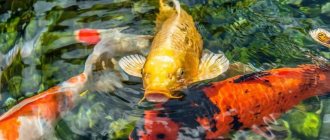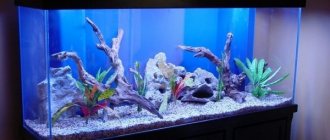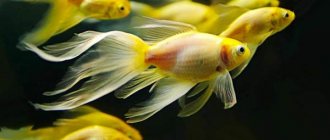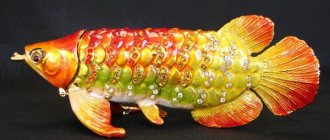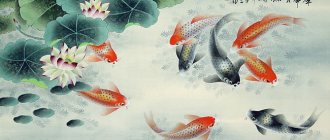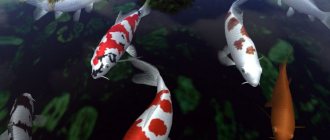- Wild animals
- >>
- Fish
Aravana is a fish that is one of the most ancient marine inhabitants. It is considered a large and quite strong fish. It can be kept at home if the size of the aquarium allows it. In many literary sources, the arawana can be found under the name “sea dragon” because of its dense scales. Such scales form a so-called dense protective shell on the body of a marine inhabitant. However, despite its heaviness, it does not fetter the fish at all and does not limit its mobility. Aravana comes in many varieties, differing from each other in color, body shape and size.
Description
Aravana is a predatory fish. In nature, it lives in large rivers and basins of America, Africa and Southern China. The origin of freshwater fish begins in South America. In addition to being kept in an aquarium, arowana is used as food. Asian arowanas differ from American arowanas by having a short body.
Appearance
The fish reaches a length of 80 cm, in rare cases 120 cm. The body of the fish is long, ribbon-like, covered with large scales, which makes it look like a dragon. The fins are long and narrow, almost adjacent to the tail. The large mouth opens upward and allows the arowana to take food from the surface. Sensitive antennae are located on the lower jaw.
Behavior
The fish can jump to a height of 3 m from the surface and swims quickly. A skilled hunter, capable of obtaining food even on land. In nature, arowanas build a clear hierarchy when the dominant individual occupies a territory and does not allow weaker relatives to approach it. In the same aquarium, two individuals will inevitably have violent clashes. Despite their bloodthirstiness, dragon fish are shy. A sharp bright light or a sudden sound will cause the arowana to rush around the aquarium in panic. Smart fish that recognizes its owner.
Lifespan
Arowana lives 7–10 years with good care.
Features of character and lifestyle
Photo: Light Aravana
Aravans are considered highly intelligent predators. They are able to recognize their owner, eat food from his hands and even allow themselves to be touched. In general, predators by nature are quite aggressive and extremely unfriendly. When kept in aquarium conditions, they will not be able to coexist peacefully with other species of fish.
They don't like to share their space with anyone else. Smaller and weaker individuals run the risk of being eaten. Only fish of similar size, preferably also predators, can be considered as neighbors. Stingrays get along well with Aravans. They have similar body sizes, taste preferences and occupy different water columns, which eliminates competition between them.
Predators are excellent at navigating the terrain, preferring quiet backwaters and shallow depths. In such places they are most comfortable, where they feel like full owners. They are very jealous of their habitat.
If the fish is kept in an aquarium and there are other inhabitants in addition to the predator, you must adhere to the following rules:
- feed the fish in a timely manner and in sufficient quantity;
- comply with all rules and conditions for keeping fish;
- provide the required number of shelters and pieces of wood.
Under natural conditions, fish can easily coexist next to catfish, fractocephalus, Indian knives, and astronotuses.
Kinds
There are approximately 200 species of arowana, but about 10 are often kept in aquariums. The silver arowana is popular and is sold at a more affordable price.
Asian red
Famous and expensive fish from Southeast Asia. Body color is bright red. Endangered species. The owner must have a certificate of ownership.
Golden
Another endangered species. Young fish look less impressive than adults. The fish has a rich yellow-gold color and five horizontal rows of scales.
Interesting Facts
Origin
This fish is considered very ancient. In fact, Osteoglossiformes appeared over 100 million years ago. How was this determined?
Yes, it’s very simple: the remains of ancient rocks with fish prints were found, which completely coincide with the living specimens. Naturally, scientists did an analysis and calculated the approximate age of these fossils - from 45 to 145 million years.
In China, there is a belief that “river dragons” bring prosperity and material wealth to the home. Since ancient times, wealthy Chinese have kept these fish in their homes to attract wealth. Later the fashion spread to the Old World.
Price
Now fry can be purchased for prices ranging from $20 to $500, depending on the breed, size, color quality and place of origin. However, it is very problematic to find them in the domestic retail chain. We need to order.
In legal nurseries, each grown-up individual is implanted with a microchip, which can be used to determine its age, country of origin, and species. In addition, the parameters of this chip are entered into the relevant documents when purchasing a copy. Of course, adult fish raised in such a nursery are valued very highly.
For example, for a 40-centimeter platinum arowana, which has been living in the aquarium of a Singaporean businessman for many years, a fabulous price of 80,000 US dollars was offered, but the owner flatly refused to sell his “dragon”.
Features of behavior
During the hunt, the arowana seems to hang in the water column, standing against the current. When any swimming prey approaches, it makes a sharp and powerful jerk, capturing the victim with its wide-open mouth.
The predator can make high jumps and grab small birds and other living creatures from tree branches hanging above the water.
Arowanas are frightened by sudden flashes of bright light. That’s why, when you come home in the evening, you first turn on the general lighting in the room, and then the light source in the aquarium itself.
It has been established that “dragons” have intelligence. They get used to their owner, recognize him, calmly allow themselves to be stroked and even take food from their hands, but they do not like large human companies. It is not recommended to hold noisy parties where this decorative giant lives.
Content
Such rare and exotic fish live in professional aquariums. The equipment, the aquarium and the fish itself are very expensive.
Aquarium
You will need a tank with a volume of 800–1000 liters made of durable material, such as plexiglass. A heavy lid is required on top, as the fish jump out of the water. For decorations, use large driftwood.
Water parameters
| Temperature | 20–30 degrees |
| pH value | 6–7,5 |
| Rigidity | 8–12 dGH |
| Water movement | moderate or weak |
Change the water once a week by 25%. Do not allow sudden changes in parameters. Periodically test the water for hazardous chemicals and add water conditioner if necessary.
Plants
Plants in an arowana aquarium are not necessary. If you want to plant plants, choose flora with a strong root system:
- Vallisneria;
- Java fern;
- Anubias.
It is better to prepare small pots for plants; with such planting they will be less vulnerable. Use artificial plants as an alternative to living greenery.
Priming
Choose soil with a large diameter without sharp corners. For the rest, be guided by your own preferences. The bottom, strewn with leaves, will recreate the natural habitat in the aquarium. Siphon the soil thoroughly once a week.
Feeding
The arowana's diet consists mainly of animal feed:
- frogs;
- tadpoles;
- coreters;
- grasshoppers;
- mice;
- beef and chicken heart;
- crickets;
- bloodworm;
- small fish;
- shrimp;
- mussels;
- Zhukov.
Some animals, such as fish and crickets, can be raised at home. Fish and insects should not show signs of illness. Treat feed in baths of methylene blue solution, others in boiling water. Remove the fat from the meat and cut into 1 cm pieces. Do not overfeed the predators; give them a fasting day 1-2 times a week. In its natural environment, the arowana occasionally consumes plant foods such as aquatic plants and fruits that have fallen into the water.
Compatibility
Optimally single content. Goldfish, viviparous fish, carp fish and medium-sized cichlids are regarded exclusively as food. It is acceptable to keep an arowana with large neighbors:
- paku;
- giant gouramis;
- astronotuses;
- Indian knife;
- slobbering catfish;
- plecostomus;
- brocade pterygoplicht.
Do not allow the predator to go hungry, equip the aquarium with numerous hiding places and maintain the most comfortable conditions, then the arowana will get along with its neighbors.
View this post on Instagram
My aquarium Double Tap & Comment Below ?FOLLOW FOR MORE @polysaur_jurassicfish #bichir #endlicheri #senegalus #fish #bichirbichir #delhezi #primitivefish #freshwater #congicus #fishtank #aquarismo #aquario #freshwaterfish #aquariumhobby #exoticpet #africanfish #bichirs #aquarium # fish #ポリプテルス #fish #arowana #jardini #garfish #spottedgar #monsterfishkeeper #polypterus #アロワナ #poytara #mbreda
A post shared by Primitive fish (@polysaur_jurassicfish) on Sep 28, 2022 at 5:26pm PDT
Reproduction
Arowana does not breed in an aquarium. It is possible to breed fish in ponds and pools.
Sex differences
Sexual dimorphism is weakly expressed. The male looks somewhat more graceful and has a long anal fin. In some species, the color of males is more intense.
Spawning
Fish spawn in warm water. The male carries the eggs, 1.5 cm in diameter, in his mouth for 4–5 weeks and is in no hurry to release the fry even after hatching. The young begin to swim independently after 3–4 days. First, the fry feed on the contents of the yolk sac, then on daphnia, worms or insect larvae.
Breeding
Reproduction under artificial conditions is often difficult. The thing is that fish are extremely sensitive to housing conditions, and if they are unsuitable, the female’s eggs will not mature.
Arowana spawning lasts from December to January. In one clutch, a female can lay up to 200 large yellow eggs. Typically, about 15-30 fry eventually survive.
Arowanas are wonderful parents. The incubation period of eggs, lasting more than 50 days, takes place in the male’s mouth. When the babies hatch, the male continues to carry them until the yolk sac dissolves and the fry begin to feed on their own.
Diseases
The water dweller has a strong immune system. The fish does not have any species-specific diseases and is susceptible to the same diseases as other aquarium fish. The disease starts in the aquarium due to infrequent and improper maintenance. If a white coating or dots appear on the fish’s body, the pet has a fungal infection. Treat the predator with malachite green or medications containing phenoxyethanol. Poisoning and temperature shock require gradual improvement of conditions and adjustment of temperature to a comfortable level.
Possible problems
Arowanas have excellent immunity and very rarely get sick. But if the conditions of their detention have deteriorated significantly, this can happen.
Most often, fish suffer from overeating and obesity. This should not be allowed; it is important to arrange fasting days.
Another problem for the huge predator is a sedentary lifestyle due to the tightness of the tank. If juveniles can be placed in a 200 liter aquarium, then as the individual matures and grows, it must be transplanted into a more spacious one. Ideally, for an adult pet, the length of an artificial pond is two meters.
The first sign of Arowana disease is refusal to eat.
Cloudiness of the cornea of a pet's eyes occurs due to too low a water temperature or excessive contamination. The gill plates may then begin to curl over, resembling ears. The water in the tank should be replaced immediately. This procedure may have to be repeated more than once.
Due to feeding the Arowana with food contaminated with parasites and even due to smoking near an artificial pond, the fish can be affected by toxicosis. In its acute form, the pet sinks to the bottom and does not move or convulses near the surface. In chronic cases, loss of appetite and glassy eyes, lethargy and apathy occur. In this case, the Dragon Fish should be immediately transferred to a clean tank, and the main aquarium should be washed and restarted.
For food poisoning, take baths with Methylene blue and a weak salt solution (1 g per 1 liter of water).
Arowana owners often encounter injuries to their pets as a result of fights, bites, wounds, and bruises when jumping out of the tank. As a treatment, short baths with table salt are given to the affected individual three times a day.


